Electronic Music Concert
Michael shared a passion for modern music with his friend Paul Griffiths, and together they planned a concert of electronic music recorded on tape, to take place in October 1971. This could have been put on quite cheaply by using a College meeting room, but to ensure a comfortable experience for the audience, they took the financially risky step of hiring the University theatre, the Oxford Playhouse. Paul organised the publicity and raised funds for the event, while Michael arranged the sound reproduction. They agreed that in order to do justice to the music, the quality of reproduction must be as high as possible, and comparable to that which could be obtained from the best equipment in a domestic setting. The existing sound equipment in the theatre was judged to be wholly inadequate, and so Michael borrowed equipment (and manpower!) from OUTRS members and elsewhere. The challenge was to scale up the power of domestic equipment to provide a high quality undistorted sound level in a much larger space than a normal living room.
Planning started several months in advance, at a time when Michael was not only unwell but also heavily involved in organising the tetrahedral recording session [Tetrahedral Recording] and challenging CBS over the SQ system [Commercial Quadraphonics].
Peter was designing a very low distortion 30 Watts per channel Class A transistor amplifier, and was keen to build as many as were needed in time for the concert. The cost of components alone for the amplifier was about £40, almost a month’s income for those on student grants, so it was an expensive item.
Rehearsal
First, Michael conducted a rehearsal in the theatre using a single pair of Quad valve amplifiers and Electrostatic speakers. The theatre management allowed us to set up during the day, so the experiment was carried out against the incongruous backdrop of an Edwardian set, ready for the evening performance. For the concert itself, Paul and the theatre lighting technician designed colourful and dramatic lighting effects that complemented the mood of the various compositions.
In the rehearsal, the stereo effect was quite good, but there was gross distortion which at first we thought was on the tape, but in fact was due to amplifier/speaker overload. The distortion was worst in the mid-bass, not in the treble which was where it was expected. Michael was worried that the distortion was unacceptable, and that even six amplifiers and speakers might not give sufficient volume, allowing for the effect of the audience in absorbing the sound. He was also concerned that the Quad speakers would provide insufficient bass in the theatrical setting, and arranged for the use of two ‘labyrinth’ bass units from a local hi-fi dealer. Peter devised a simple way of feeding these units with the bass signal only, so Michael was greatly relieved.
Click on the image to see a larger version
 1-thumb.jpg)
 2-thumb.jpg)
 5-thumb.jpg)
Building the Class A amplifier
Peter continued to refine the design of his new amplifier, while Richard worked on the construction. There were various crises when they found it was oscillating, or ‘blew up’ due to overload or component failure. The photos show Peter and Richard working on the amplifier in the Astrophysics Department, where Peter was carrying out research for his doctoral thesis.
Click on the image to see a larger version
 30-W-2 web-thumb.jpg)
 30-W-1-web-thumb.jpg)
 30-W-3-web-thumb.jpg)
 30-W-4-web-thumb.jpg)
 30-W-8-web-thumb.jpg)
Concert
Paul had been involved in lengthy negotiations with composers and their agents to obtain permission to play the chosen compositions. Success was gratifying: ‘Paul was absolutely ecstatic with joy, because Pierre Boulez has personally written to say that we can play tapes of his early Etudes!’
The day before the concert found the team in a state of gloom, because fewer advance tickets had been sold than Paul had hoped. However, the Arts Council had offered a last-minute grant of £50, so that was some good news.
In the event, the concert was a success both technically and musically, and was well-received by the audience, which was larger ‘than our wildest dreams…Paul says he just about broke even…’ Setting-up took all day and was only completed at the last minute as usual. It took all our resources of people, cars and trolley journeys to assemble the equipment and take it all away again afterwards. We used six Quad speakers plus the two labyrinths, driven by three pairs of Quad valve amplifiers, a Linsley-Hood Class A transistor amplifier and the only 30 Watt Class A amplifier that had been completed in time. The photos show the loudspeaker layout, in which two Quad speakers and a labyrinth formed the left and right groups, and two Quads formed a central pair which played ‘at low level – they didn’t contribute much except possibly to the Stockhausen, which had more than two- or three-point directionality’. I enjoyed the pieces ‘more than I expected, especially those in the second half – even the Kunst seemed good’. I had previously not been impressed by the Sherlaw Johnson piece which Paul had played to us earlier, but at the concert it ‘seemed more inventive and positively the best item in the concert’. We were gratified that the audience applauded at the end of the concert – there is less incentive to applaud at concerts in which there are no visible performers, so we took the applause as recognition of the efforts in putting on the event as well as showing enjoyment of the music.
Click on the image to see a larger version
 6-thumb.jpg)
 10-thumb.jpg)
 9-thumb.jpg)
 12-thumb.jpg)
 17-thumb.jpg)
 11-thumb.jpg)
 13-thumb.jpg)
 18-thumb.jpg)
 19-thumb.jpg)
Lemon and honey
After clearing up, we congregated at 100 Abingdon Road, the house shared by Paul, Peter and other students. Late nights at Abingdon Road were often accompanied by the ritual of ‘lemon and honey’, a drink that was preferred by those who believed that coffee might keep them awake. The photos show Paul giving a virtuoso demonstration of the art of making this delicious concoction.
Click on the image to see a larger version
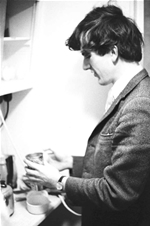
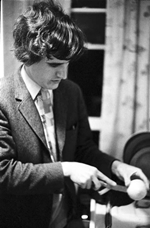

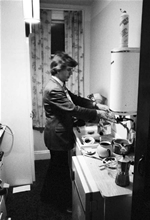
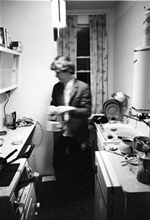
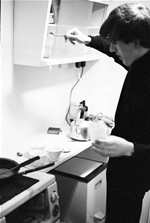
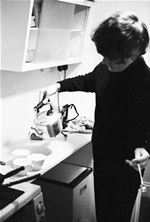

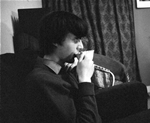
Programme – Electron I
17 October 1971, Playhouse Theatre, Oxford
| Roberto Gerard | Audiomobile 2 DNA |
| Pierre Boulez | Etudes |
| Luciano Berio | Thema – Omaggio a Joyce |
| Milton Babbitt | Ensembles for synthesiser |
| Vladimir Ussachevsky | Of wood and brass |
| Interval | |
| Robert Sherlaw Johnson | Green whispers of gold II |
| Jos Kunst | Expulsion |
| Henri Pousser | Scambi |
| Karlheinz Stockhausen | Telemusik |